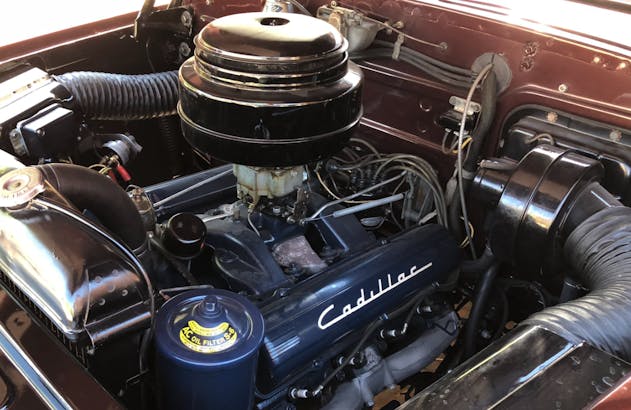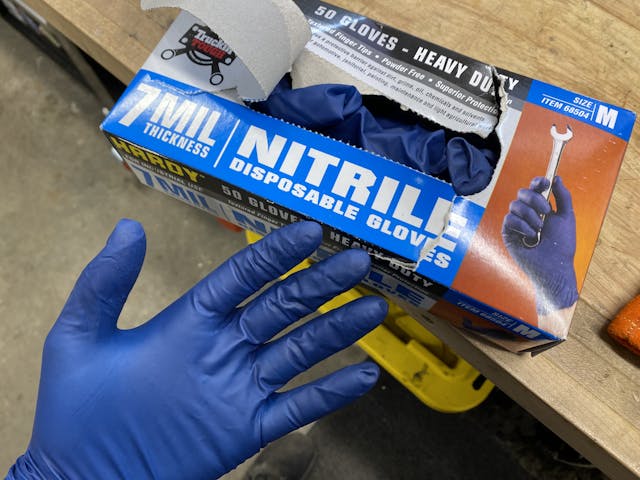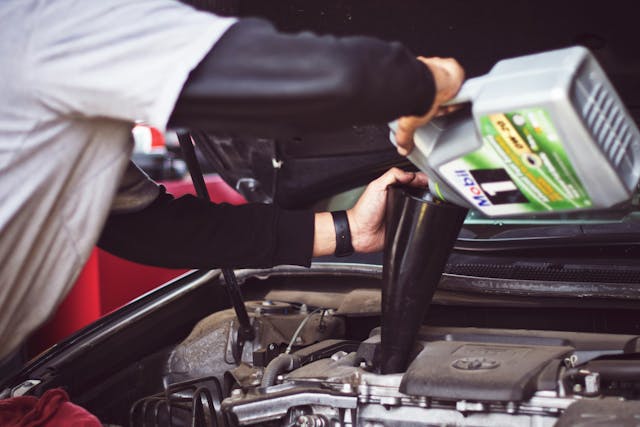8 oil change dos and don’ts
It’s a small job that somehow became a rite of passage for gearheads: Oil changes. The draining and refilling of engine oil is the first task that many budding wrench-turners undertake, and its certainly an important one. Like any other task in the automotive world, there are some pieces of institutional knowledge that comprise the key dos and don’ts for a smooth oil change. So let’s put these lessons learned out in the open, with the mission of shortening the process for newbies. And perhaps to reinforce some best practices for you veteran mechanics?
Don’t go crazy with warm-up

Modern oils are pretty amazing at suspending particles and contaminants, but there is still some junk that sinks down to the bottom of the pan. It needs to be stirred up to ensure it escapes when you pull the drain plug. Starting the engine and letting it idle for a minute or two is perfect for that final circulation. Run it any longer and you’re rewarded with nothing more than scalding hot oil that does nothing more than burn you. Before you pull that (drain) plug, give the engine a minute after shutting down, allowing the oil to drain to the pan from the nooks and crannies higher in the engine. But before you get underneath the vehicle to do the deed, remember you must…
Wear disposable gloves

Nitrile gloves keep you from soaking up solvents and oils into your skin. I’ve found 7mil thick to be a nice sweet spot of durable and affordable.
We all know the guy at the auto parts counter who has seriously gnarly hands from all the years being soaked in oil over decades of engine builds. That’s the visible damage. The invisible damage is sitting in your internal organs. All the hydrocarbons that get absorbed through the skin and are processed in our gut where they can’t be broken down. They end up accumulating in our body, which can cause serious health complications after years and years of chemical exposure. Preventing those issues is easy as putting on a pair of nitrile gloves. Use them even if it’s only for pulling the filter and drain plug, which you can do efficiently with…
The drain plug trick

It’s not groundbreaking, but nothing feels better than the perfect pull on a drain plug to ensure you don’t get any oil on your hand. The trick is pressure, not pulling. As you unthread the plug by hand, push in–against the bolt as in comes out–so the threads act as a seal with the outer edge. With a little practice you can get the pressure right (while not rocking the plug in the threads) and can spin the plug a full turn to feel for the “click.” That click means the bolt overlapped the last thread. With a swift motion away from the direction of oil flow, remove that now-loose plug. Presto! This can make thin viscosity oil changes much cleaner, and thick stuff like 20-50 can sometimes be spotless. In your excitement of not having a mess to clean up after draining, make sure you…
Don’t over tighten the drain plug or filter

It’s come to the point where stuck filters and stripped drain plugs are no longer a joke. Neither the filter nor plug require any real torque when installed properly. Use a small amount of oil to lube the filter’s rubber seal, then spin it into place. After the gasket seats on the housing, turn it only about three-quarter of an additional turn. Some applications might call for a full turn, but that is usually reserved for heavy duty equipment. Any tighter than what the filter manufacturers call for and you run the risk of deforming that rubber seal, which could cause oil to leak past the seal. That’s bad news. Any oil spillage is bad, so when you are filling…
Just use a funnel

The oil fill port on most engines is in that perfect spot where it looks like you could pour directly into it, except that’s a lie. They seem to be ideally located, but cleaning up if you miss (by even the smallest margin) can be a major pain. Are we really going to work so hard to spot and address leaks, to keep our engines clean, and just ruin it while doing routine maintenance?
I’m not. A funnel all but guarantees I won’t have to do any clean up after filling, even if I’m distracted or letting my 7 year-old niece do the filling. Putting in that fresh oil feels good, but be careful and…
Don’t overfill

This shows the rotating assembly without the oil pan and it’s easy to tell how oil at too high of a level would be bad.
Too much oil is just as bad as not enough. Seriously. The oil level in a wet-sump engine is carefully calculated to keep the rotating assembly from whipping through the oil. That action causes foaming, and oil foam pushed through the oiling system is the same as not having oil at all. I don’t need to tell you how bad that can be, so check the service or owners manual for the proper fill level. When done, look at the dipstick as a double check. Luckily, the empty oil containers you now have at this point are are perfect to…
Recycle your used oil

It’s never been easier to properly recycle used oil, so there is no excuse to do otherwise. Just about any auto parts store takes it, so they should be your first trip in your freshly serviced vehicle to “return” your oil. Be sure to capture oil in a non-contaminated pan so that the oil can actually be recycled. Coolant is the main enemy here, so be sure to flush your drain pan before the oil change. Luckily you don’t have to worry about how dusty or dirty the pan is, but other fluids can defeat the purpose of recycling. But before you make the trip to recycle the oil, be sure to…
Reset the computer (or write down your service date)

Modern cars have an oil life monitoring system. Whether you trust it is a personal preference, but for the sake of eliminating confusion, go ahead and reset it now. Most reset procedures involves cycling the ignition key and pressing the throttle pedal a certain number of times. The service manual will outline it, or a quick search to an online make/model specific forum will have the instructions. If your vehicles are of the manual variety, write down the oil change date in a log book. Or consider service tracker kept in the car or garage, as it keeps you from forgetting what’s been done. Not to mention thisa paper trail shows good stewardship to a potential next owner, which can mean an easier sale for more money.
In all, oil changes can be simple and rewarding for newbies and DIY enthusiasts alike. Following these best practices will not only keep your vehicle happy, but also make the experience better for you each time. Do you have something specific you add to this process? Let us know about it in the comments below.
***
Check out the Hagerty Media homepage so you don’t miss a single story, or better yet, bookmark it. To get our best stories delivered right to your inbox, subscribe to our newsletters.



Most of the comments seems to be in regard to changing the oil on your own car…
If you are working in a shop and servicing customer’s cars, make sure you can open the hood before draining the oil.
I had a customer come in and after draining the oil, I realized the hood would not open.
The service writer said something to the customer after the fact and the customer was aware of the issue and figured we would have to get his hood open on our time…
What he failed to realize is that our oil was bought in bulk, and we had a gun to pump it out with.
I ended up filling from the bottom to the full capacity found in the service information, plugged it off, and shipped it.
If we had to rely on pouring oil, it would have been a much bigger problem.
It is also not a bad idea to verify the fill cap can be removed…
I was only able to read through about half of the comments before my head exploded.
Modern oils are NOT designed for old engines / transmissions and should NOT be used in antique cars PERIOD !
As an example , I take care of a multi car collection now, all pre 34 & back , that the owner had been bringing his rigs to a regular garage for oil changes and service , when the transmission & rear end oils were last changed, immediate issues arose in a 33 Packard & 33 Lincoln . They both started leaking profusely and both started growling like pissed off wildcats in very short order !
The oils had been changed with a modern GL4 or 5 gear lube which is the wrong viscosity , not the GL1 as required. Long story short , many seals, bearings , bronze bushings ( which I had to mill out myself ) and 6 months of searching for all the right parts and having to go to Timkin for a custom made bearing , the 33 Packard V12 is back on the road again,,,,> a year later .
DO NOT USE MODERN OILS IN ANTIQUE CARS,,,,PERIOD !!!
I’m no engineer but I have worked on antique cars for 60+ years and I’m speaking from experience here,,,,,modern oils in old cars is a No No even though some are hard to find , especially things like GL1 for rear ends and transmissions and steam pump oils , used for chassis lube systems. Sure they ,,may work,,,but your asking for trouble. A hint though, you may be able to find some of these obscure oils at tractor dealerships as old tractors used the same type oils as many antique cars do.
You went the extra mile to obtain and restore your babies, usually at great expense ,,,now maintain them properly and the way they were designed and meant to be maintained using the proper lubricants .
Neither the 3 I own or the > 20 vehicles I maintain regularly ever get modern oils nor do they ever reach the recommended oil change intervals before the maintenance is done.